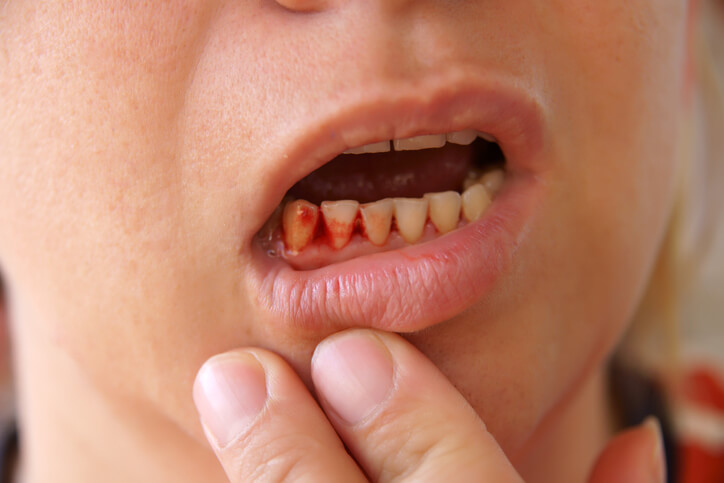
What is gum infection?
Often referred to as gum disease, a gum infection can be a painful condition. There are three stages to gum disease: gingivitis, periodontitis and advanced periodontitis.[1]
What causes gum infection?
Gum infection and gum disease is caused by the build-up of bacteria and plaque on your teeth. This often happens if you do not effectively clean your teeth regularly. Over time, this plaque hardens into a tartar that cannot be removed by brushing or flossing alone. Bacteria accumulate and infect your gums, causing pain and inflammation.
If the condition is left untreated, the bacteria will continue to spread along the gumline. These bacteria release toxins which damage and irritate the gums, triggering an inflammatory response. This can damage both the gums and the bones that hold your teeth in place. This is periodontitis.[1]
What does a gum infection look like?
Of the three stages of gum disease, gingivitis is the least concerning and most common. The word gingivitis is made up of the Latin ‘gingivae’, meaning gums, and ‘itis’ meaning inflammation. If you have gingivitis, you might spit blood when you eat hard foods or brush your teeth. Your gums may also become swollen, sore and red. However, sometimes gingivitis doesn’t produce symptoms – meaning you can have it without knowing.
If you don’t get treatment for your gingivitis, it may progress into periodontitis or even advanced periodontitis. Periodontitis means ‘inflammation around the teeth’. At these stages, the symptoms are more severe and may include loose teeth. As the gums pull away from the teeth, gum pockets are created, and these can also get infected if not treated.[1]
How to treat gum infection
When treating gum disease, the main goal is to reduce the inflammation. Treatment can take several forms.
- Oral hygiene
As poor oral hygiene can be a contributing factor to developing gingivitis and gum disease, it is important to improve your dental care in order to stop it getting worse. An oral hygiene routine consisting of brushing, flossing and mouthwash won’t be able to remove any hard tartar that has already built up, but it can help to prevent more forming.[1]
- Professional dental cleaning
A dentist or dental hygienist should be able to clean your teeth of plaque and tartar build up to help reduce the inflammation of your gums. It’s important to remember that this won’t fix the problem forever – you’ll need to continue brushing your teeth twice a day and using floss picks regularly as well, or the tartar will just build back up.[1]
- Antiseptic mouthwash
Your dentist can prescribe you a special mouthwash that contains an antiseptic compound. This will help to reduce the levels of bacteria in your mouth, and should help to slow down infection. Antiseptic mouthwash can also get into deep gum pockets where you might not be able to reach with a brush, helping to keep your mouth cleaner.[1]
- Antibiotics
If your gum disease has progressed to periodontitis, your dentist may prescribe you antibiotics to fight off the infection. These could be tablets, a solution that you drink, or a topical antibiotic cream or gel that your dentist applies for you.[1]
- Surgery
In extreme cases, your dentist may decide it is necessary to perform surgery on your gums so that they can clean the root of your teeth. They’ll then stitch your gum tissue to encourage it to reattach to your teeth.[1]
How to prevent gum infection
As with any disease or infection, it’s better to prevent gingivitis and periodontitis than to have to treat them. Here are some ways you can try to prevent gum disease:[1]
- Brush your teeth twice a day
- Use a fluoride mouthwash (but not right after brushing)
- Clean between your teeth using floss picks or interdental brushes
- Remove bacteria from your tongue with a tongue cleaner
- Quit smoking
- Eat a healthy, balanced diet
- Attend dentist check-ups regularly
Resources:




